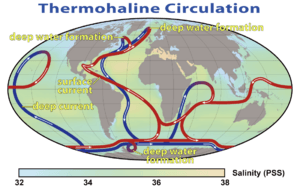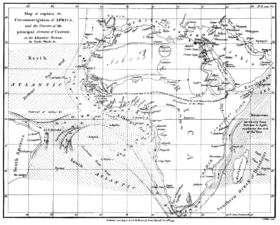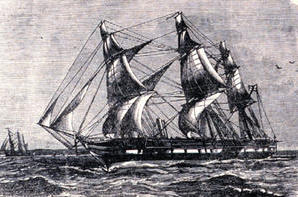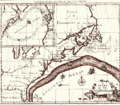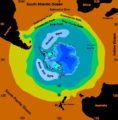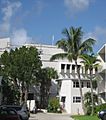Oceanography facts for kids
Oceanography is the scientific study of the ocean. It's also called oceanology, sea science, or marine science. This science looks at everything about the ocean, from tiny living things to huge currents and even the rocks at the bottom.
Oceanography is part of Earth science. It combines ideas from many other sciences. These include biology (the study of living things), chemistry (the study of substances), geology (the study of Earth's rocks), and physics (the study of energy and forces). Oceanographers are scientists who study all these different parts of the ocean.
Contents
History of Oceanography
Early Discoveries
People have been learning about the ocean for a very long time. Even in ancient times, people watched the waves and currents. For example, Aristotle and Strabo wrote about tides over 2,000 years ago. Early explorers mainly mapped the ocean surface. They also learned about sea animals from fishermen. They could measure how deep the water was using a lead line.
The Portuguese were some of the first to study the Atlantic Ocean systematically. They explored the currents and winds for many decades. A scientist named Pedro Nunes (1502–1578) helped them understand how to navigate. He explained that Portuguese sailors were well-trained. They used special tools and knowledge of astronomy and geometry. They also had detailed maps.
One big challenge for sailors was returning from south of the Canary Islands. The winds and currents there made it very hard to sail north. To solve this, the Portuguese developed a special route called the 'volta do mar'. This route took them far out into the ocean. It helped them catch winds that would bring them back to Europe. This knowledge was very important for finding a sea route to India around Africa.
Much of the detailed records of Portuguese voyages were lost in the 1755 Lisbon earthquake. However, we know they studied the ocean carefully. They understood how winds changed with the seasons. This allowed them to plan different routes at different times of the year. For example, Vasco da Gama and Pedro Álvares Cabral took different paths to India. This showed they knew a lot about ocean conditions. Their deep understanding of the ocean even helped Portugal in negotiating the Treaty of Tordesillas in 1494. This treaty divided new lands between Portugal and Spain.
The Danish expedition to Arabia (1761–67) was one of the first true oceanographic trips. Scientists on the ship Grønland studied marine life. They even tried to find out what caused "milky seas." They used special nets and tools to collect samples from deep waters.
Juan Ponce de León first noticed the Gulf Stream in 1513. But Benjamin Franklin was the first to study it scientifically. He measured water temperatures during his trips across the Atlantic. Franklin and Timothy Folger then made the first map of the Gulf Stream in 1769–1770.
Explorers like James Cook and Louis Antoine de Bougainville gathered information about the Pacific Ocean currents. James Rennell wrote some of the first science books on oceanography. He described currents in the Atlantic and Indian Oceans. He also understood the "Rennell's Current" near the Isles of Scilly.
It's important to know the difference between tides and currents. Tides are the rising and falling of sea levels. They are mainly caused by the Moon's gravity. Ocean currents are continuous movements of seawater. They are caused by things like wind, the Coriolis effect, and differences in water temperature and saltiness.
In 1840, Sir James Clark Ross made the first modern deep-sea measurement. Charles Darwin wrote about reefs and atolls after his voyage on HMS Beagle. Edward Forbes started marine ecology in 1841–1842 by dredging in the Aegean Sea.
Matthew Fontaine Maury was a key figure in early American oceanography. He studied marine weather, navigation, and charted winds and currents. His 1855 book, Physical Geography of the Sea, was one of the first complete studies of the ocean. Many countries sent their ocean observations to Maury. He then shared the results worldwide.
Modern Oceanography Begins
For a long time, people only knew about the top layers of the ocean. They knew very little about the deep parts. In the mid-1800s, the British Royal Navy mapped coastlines around the world. This showed that most of the ocean was very deep. People became more curious about the unexplored oceans.
A major step in modern oceanography was the Challenger expedition from 1872 to 1876. This was the first true oceanographic research trip. It set the foundation for the entire field. The British Government sent Challenger on this journey. The ship was specially changed for science. It had labs for studying nature and chemistry.
Under the guidance of Charles Wyville Thomson, Challenger traveled almost 70,000 nautical miles. The crew took 492 deep-sea measurements. They also collected 133 samples from the ocean bottom. They found about 4,700 new species of marine life. The expedition's findings were published in a huge report. Sir John Murray, who oversaw the report, called it "the greatest advance in the knowledge of our planet." He later started the study of oceanography at the University of Edinburgh. Murray was the first to study deep ocean trenches and map ocean sediments. He also correctly understood how coral reefs form.
Other countries also started sending out scientific expeditions in the late 1800s. The first ship built just for oceanography, Albatros, was made in 1882. In 1893, Fridtjof Nansen let his ship, Fram, freeze into the Arctic ice. This allowed him to collect data about the ocean, weather, and stars for a long time.
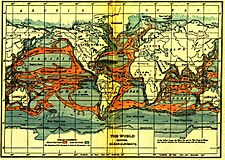

In 1881, geographer John Francon Williams published an important book called Geography of the Oceans. Later, Otto Krümmel's Handbuch der Ozeanographie (1907-1911) helped more people become interested in oceanography. The 1910 North Atlantic expedition, led by John Murray and Johan Hjort, was a huge research project. It led to the famous 1912 book The Depths of the Ocean.
The first time sea depth was measured using sound was in 1914. From 1925 to 1927, the "Meteor" expedition used an echo sounder. They took 70,000 depth measurements. This helped them map the Mid-Atlantic Ridge.
In 1934, Easter Ellen Cupp became the first woman to earn a PhD in oceanography from Scripps. She did important work on tiny ocean plants called diatoms. However, she lost her job at Scripps in 1940. This was not because of her scientific skills. It was due to other reasons, including financial pressures. She then taught high school for the rest of her career.
In 1942, Sverdrup, Johnson, and Fleming published The Oceans, a very important book. Later, The Sea (1962) and Encyclopedia of Oceanography (1966) were also published.
Scientists continued to make big discoveries. The Great Global Rift, a huge crack along the Mid-Atlantic Ridge, was found in 1953. It was mapped by Maurice Ewing, Bruce C. Heezen, and Marie Tharp. In 1954, a mountain range was found under the Arctic Ocean. The idea of seafloor spreading was developed in 1960 by Harry Hammond Hess. The Ocean Drilling Program started in 1966. Deep-sea vents, which are like underwater hot springs, were found in 1977. This happened when Jack Corliss and Robert Ballard used the submersible DSV Alvin.
In the 1950s, Auguste Piccard invented the bathyscaphe. This special submarine, like the Trieste, could explore the deepest parts of the ocean. The United States nuclear submarine Nautilus was the first to travel under the ice to the North Pole in 1958. In 1962, the FLIP (Floating Instrument Platform) was first used. It's a 355-foot-long buoy that can flip upright to become a stable research platform.
In 1968, Tanya Atwater led the first all-woman oceanographic expedition. Before this, women oceanographers often faced limits on joining research trips.
Since the 1970s, computers have become very important in oceanography. They help scientists predict ocean conditions. They also help understand how the environment is changing. For example, a network of oceanographic buoys was set up in the Pacific. These buoys help predict El Niño events.
The World Ocean Circulation Experiment (WOCE) ran from 1990 to 2002. It gathered a lot of data about ocean currents. In 1995, data from Geosat helped map the seafloor.
Studying the oceans is key to understanding changes in Earth's climate. The ocean and atmosphere are connected through evaporation, rain, and heat exchange. Recent studies have taught us a lot about ocean acidification (oceans becoming more acidic), ocean heat content (how much heat the ocean stores), sea level rise, and Arctic sea ice decline. These studies help us understand climate change and its effects.
Overall, learning more about the ocean helps us take better care of Earth's resources. The Intergovernmental Oceanographic Commission reports that countries spend about 1.7% of their research money on ocean science.
Branches of Oceanography
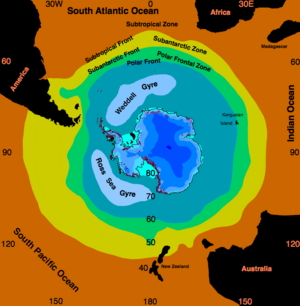
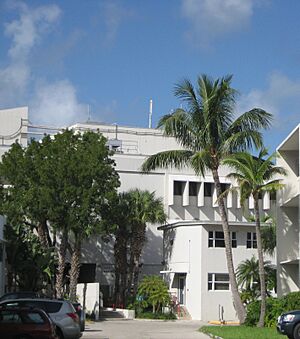
Oceanography is divided into five main areas:
Biological Oceanography
Biological oceanography looks at marine organisms. It studies how they live and interact with their ocean environment. This includes the physical, chemical, and geological features of the ocean.
Chemical Oceanography
Chemical oceanography is the study of the chemistry of the ocean. It focuses on the properties of seawater and how they change. It also looks at how different chemicals move through the ocean.
Ocean Acidification
Ocean acidification is when the ocean's pH decreases. This happens because humans release a lot of carbon dioxide (CO2) into the air. The ocean absorbs about 30–40% of this CO2. When CO2 dissolves in seawater, it forms carbonic acid. This makes the ocean more acidic. Before the industrial age, the ocean's pH was about 8.2. Now, it's below 8.1. Scientists expect it to reach 7.7 by the year 2100.
This change is a big problem for many marine animals. Animals like oysters, clams, sea urchins, and corals use calcium carbonate to build their shells and skeletons. But calcium carbonate dissolves more easily in more acidic water. This means ocean acidification can make it harder for these animals to build and maintain their shells. It also affects tiny organisms like pteropods and foraminifera. These small creatures are important parts of the ocean's food chain. In tropical areas, corals are especially at risk. They might not be able to build their calcium carbonate skeletons. This would harm all the other creatures that live on coral reefs.
The ocean's chemistry is changing faster than ever before in Earth's history. This makes it hard to know how marine life will adapt. Scientists are especially worried about how acidification will combine with other problems. These include warmer ocean temperatures and lower oxygen levels.
Geological Oceanography
Geological oceanography studies the geology of the ocean floor. This includes topics like plate tectonics (how Earth's large plates move) and paleoceanography (the history of the oceans).
Physical Oceanography
Physical oceanography studies the ocean's physical features. This includes water temperature and saltiness. It also looks at how water mixes, waves, tides, and currents.
Ocean Currents
Ocean currents have been a major interest since early ocean expeditions. Tides, the Coriolis effect (a force from Earth's rotation), wind, and differences in water temperature and saltiness are the main things that create ocean currents. The thermohaline circulation (THC) is a huge system of currents. It connects all the ocean basins. It's driven by the density of seawater, which depends on temperature and salt content. This system is now often called the 'meridional overturning circulation'.
Examples of strong, continuous currents include the Gulf Stream and the Kuroshio Current. These are powerful currents driven by wind.
Ocean Heat Content
Oceanic heat content (OHC) is the extra heat stored in the ocean. This heat comes from changes in Earth's energy balance. When the ocean gets warmer, it plays a big role in sea level rise. This is because warmer water expands. Since 1971, about 90% of the extra heat from global warming has been absorbed by the ocean.
Paleoceanography
Paleoceanography is the study of the ocean's past. It looks at how ocean currents, chemistry, biology, and geology have changed over time. Scientists use models and clues from the past to understand how ocean processes affect global climate. This helps them reconstruct past climates. Paleoceanography is closely linked to the study of past climates (palaeoclimatology).
Oceanographic Institutions
The first international oceanography groups were formed around 1900. These included the International Council for the Exploration of the Sea (1902) and the Mediterranean Science Commission (1919). Many marine research institutes already existed. Some early ones were the Stazione Zoologica Anton Dohrn in Italy (1872) and the Laboratory of the Marine Biological Association in the UK (1884).
In the United States, the Scripps Institution of Oceanography was founded in 1903. Later came the Woods Hole Oceanographic Institution (1930) and the Virginia Institute of Marine Science (1938). In Australia, the Australian Institute of Marine Science (AIMS) started in 1972. It became important for tropical marine research.
In 1921, the International Hydrographic Bureau was created. It's now called the International Hydrographic Organization. Its job is to set standards for mapping oceans and creating nautical charts.
Related Fields of Study
- Biogeochemistry (study of chemical cycles in living things and Earth)
- Biogeography (study of where living things are found)
- Climatology (study of climate)
- Coastal geography (study of coastlines)
- Environmental science (study of the environment)
- Geophysics (study of Earth's physical processes)
- Glaciology (study of glaciers and ice)
- Hydrography (mapping of water bodies)
- Hydrology (study of water on Earth)
- Limnology (study of fresh water)
- Meteorology (study of weather)
- MetOcean (study of meteorology and oceanography together)
Images for kids
-
Benjamin Franklin's 1770 map of the Gulf Stream
-
1799 map of the currents in the Atlantic and Indian Oceans, by James Rennell
-
Ocean currents (1911)
-
A plaque for writer and geographer John Francon Williams FRGS.
-
Oceanographic frontal systems in the Southern Hemisphere
-
The Applied Marine Physics Building at the University of Miami in 2007.
See also
 In Spanish: Oceanografía para niños
In Spanish: Oceanografía para niños
- List of seas
- Ocean optics
- Ocean color
- Ocean chemistry


